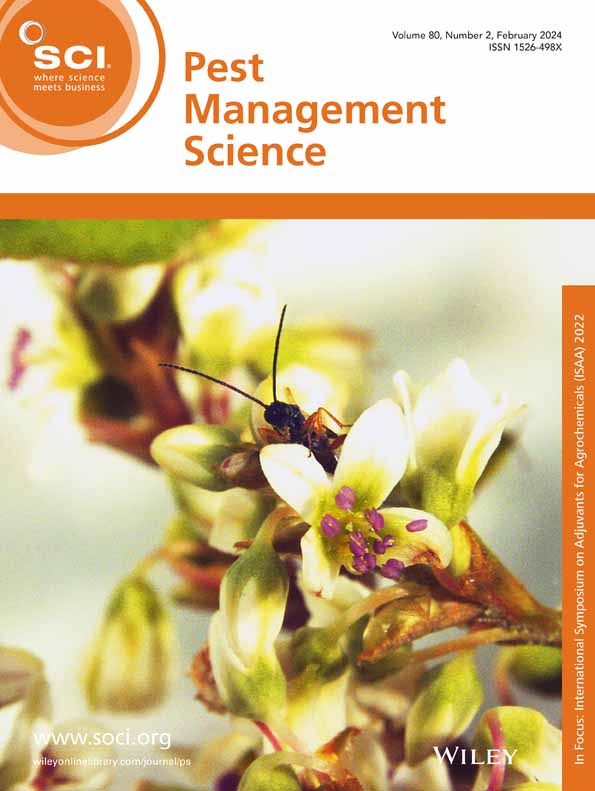Shocking results: interspecific variation in response to low-energy electrocution for weed control at various phenological stages.
IF 3.8
1区 农林科学
Q1 AGRONOMY
引用次数: 0
Abstract
BACKGROUND Low-energy electrocution and robotics are emerging technologies in weed management. Optimizing robotic weed-electrocution platforms require biological insights to improve energy efficiency and operational effectiveness. Although previous studies have shown varying sensitivity across species and growth stages, precise energy thresholds for control remain unclear. This study aimed to quantify energy requirements for effective weed control across species and developmental stages using dose response methodology. RESULTS Significant interspecific variation was observed. The dicots species Amaranthus retroflexus and Solanum nigrum were more sensitive to electrocution than the monocots Sorghum halepense and Setaria adhaerens, with S. halepense exhibiting the highest resistance. At the four true-leaf stage, ED90 estimated values ranged from 0.009 W h (A. retroflexus) to 0.099 W h (S. halepense), demonstrating high variability in energy requirements. Sensitivity declined at advanced growth stages, with ED90 values increasing by up to fourfold, confirming the hypothesis that younger plants are easier to control. Rhizome-originated S. halepense plants were more resistant than seed-originated ones at early stages, but this difference diminished at advanced growth stages. Survival varied significantly between experimental runs, highlighting potential variability in plant physiology or environmental factors. Biomass ratio responses were more consistent and useful for optimizing doses. CONCLUSION Low-energy electrocution is a promising weed control method, especially when applied at early growth stages. Efficacy is influenced by species, growth stage and propagule type. Establishing precise energy requirements for control can enhance the efficiency and performance of this technology, optimizing its application as part of integrated weed management. © 2025 Society of Chemical Industry.令人震惊的结果:在不同物候阶段,低能量电刑对杂草控制的反应存在种间差异。
背景:低能耗电刑和机器人技术是杂草管理的新兴技术。尽管先前的研究表明,不同物种和生长阶段的敏感性不同,但控制的精确能量阈值仍不清楚。本研究旨在利用剂量反应方法量化不同物种和发育阶段有效控制杂草所需的能量。结果观察到明显的种间变异。双子种逆花苋(Amaranthus retroflexus)和龙葵(Solanum nigrum)对电刑的敏感性高于单子种高粱(halepense)和尾草(Setaria adhaerens),其中尾草的抗性最高。在四个真叶阶段,ED90的估价值从0.009 W h(逆转录草)到0.099 W h(海参)不等,表明能量需求的高度变异性。在生长后期,敏感性下降,ED90值增加了四倍,证实了年轻植物更容易控制的假设。根茎来源的海葵植株在早期抗性强于种子来源的海葵植株,但这种差异在生长后期逐渐减弱。在不同的实验运行中,存活率有显著差异,突出了植物生理或环境因素的潜在可变性。生物量比响应更一致,有助于优化剂量。结论低能电刑是一种很有前途的杂草防治方法,尤其适用于生长初期。效果受品种、生育期和繁殖体类型的影响。建立精确的控制能量需求可以提高该技术的效率和性能,优化其作为综合杂草管理的一部分的应用。©2025化学工业协会。
本文章由计算机程序翻译,如有差异,请以英文原文为准。
求助全文
约1分钟内获得全文
求助全文
来源期刊

Pest Management Science
农林科学-昆虫学
CiteScore
7.90
自引率
9.80%
发文量
553
审稿时长
4.8 months
期刊介绍:
Pest Management Science is the international journal of research and development in crop protection and pest control. Since its launch in 1970, the journal has become the premier forum for papers on the discovery, application, and impact on the environment of products and strategies designed for pest management.
Published for SCI by John Wiley & Sons Ltd.
 求助内容:
求助内容: 应助结果提醒方式:
应助结果提醒方式:


